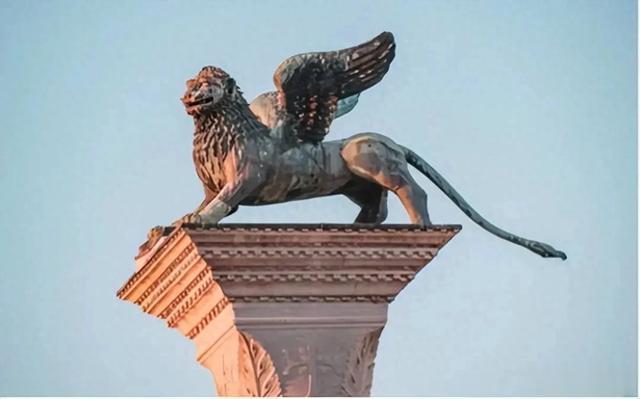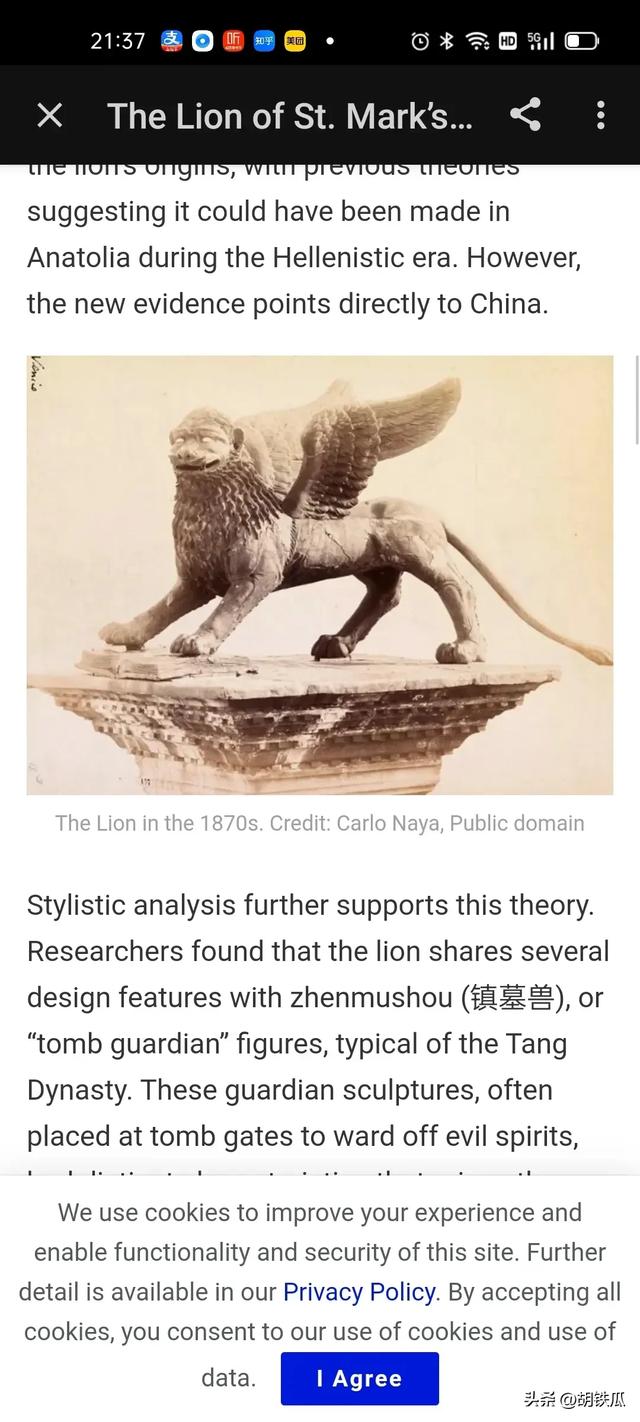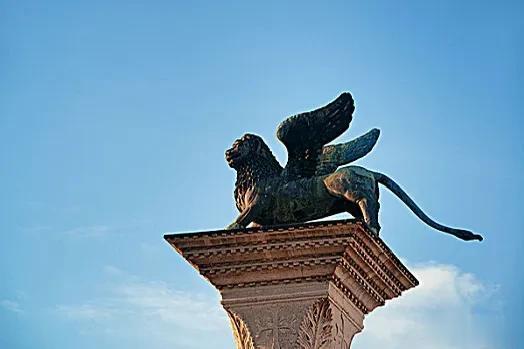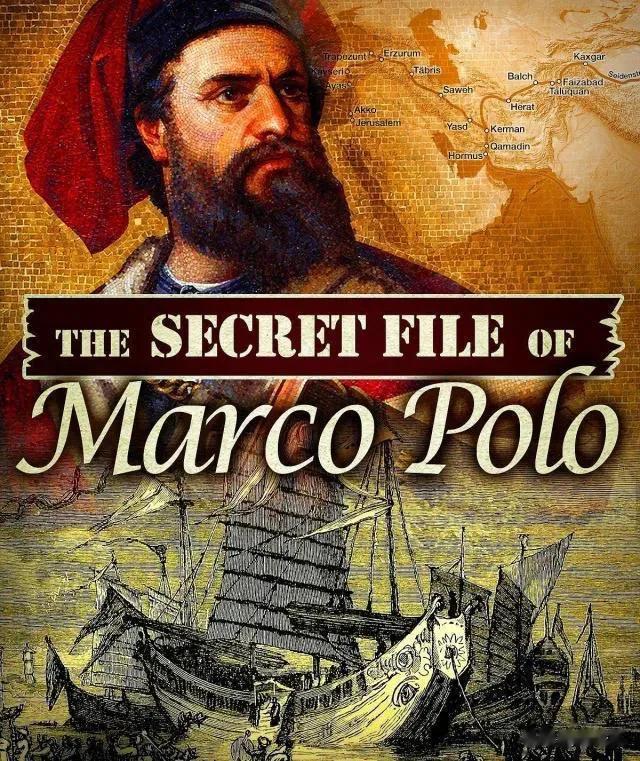意大利威尼斯圣马可广场的飞狮雕像在那里已经矗立了近千年的时间了,已知最早提及威尼斯飞狮雕像的文字记录是在1293年。但在此之前它可能已经存在一段时间了,只是缺乏明确的记载。

这座雕像堪称是意大利的国宝,也是西方现存的最顶级的雕塑之一。而在拿破仑称霸欧洲的时期,这位法国皇帝曾经点名要求把这座雕像从意大利抢到巴黎,使得意大利人曾经在一段时间内痛失他们的国宝,不过好在在拿破仑失势之后,这个国宝又被法国人送还给了意大利!
可是让所有人都没想到的是,这座从文艺复兴时期开始就驰名整个欧洲,在最近的一项调查中发现,很有可能是Made in China,而且还是个镇墓兽!
以下是来自意大利学者的正经研究的原文及翻译(为了防止有比意大利人还了解意大利的人说这是我伪造的信息,所以我决定把原文和截图都发上来):
A new study has revealed that the iconic bronze-winged lion in St. Mark’s Square, Venice, may have originated in 8th-century China.
The Lion of St. Mark’s Square in Venice is Chinese: Isotopic Analyses Confirm It
Lion of Venice, Piazzetta San Marco.
The discovery comes from a multidisciplinary team of experts in geology, chemistry, archaeology, and art history from the University of Padua, the Ca’ Foscari University of Venice, and the International Association for Mediterranean and Oriental Studies (Ismeo).

一项新的研究表明,威尼斯圣马可广场上标志性的青铜翼狮可能起源于 8 世纪的中国。
《威尼斯圣马可广场的狮子是中国的:同位素分析证实》
威尼斯圣马可广场小广场的狮子。
这一发现来自帕多瓦大学、威尼斯卡福斯卡里大学以及地中海和东方研究国际协会(Ismeo)的地质学、化学、考古学和艺术史等多学科专家团队。
Through advanced metallurgical analysis, the team discovered that a significant portion of the bronze used in the lion came from the lower Yangtze River basin in southeastern China, and it was likely cast during the Tang Dynasty (618-907 CE).
Lions were initially introduced to the Han court by emissaries from Persia (modern-day Iran) and had become widely represented as guardian figures.
Lead isotope analysis of the bronze alloy provided indisputable evidence of the Chinese origin of the materials used in the statue. The results were announced on September 11, 2024, during an international conference on Marco Polo, part of Venice’s celebrations marking the 700th anniversary of the famous merchant’s death. Scholars have long debated the lion’s origins, with previous theories suggesting it could have been made in Anatolia during the Hellenistic era. However, the new evidence points directly to China.

通过先进的冶金分析,该团队发现狮子所用青铜的很大一部分来自中国东南部的长江下游流域,并且很可能是在唐朝(公元 618 年至 907 年)铸造的。
狮子最初是由波斯(今伊朗)的使者引入汉朝宫廷的,并已广泛作为守护形象出现。
对青铜合金的铅同位素分析为该雕像所用材料的中国起源提供了无可争议的证据。结果于 2024 年 9 月 11 日在一场关于马可·波罗的国际会议上宣布,这是威尼斯纪念这位著名商人逝世 700 周年庆祝活动的一部分。学者们长期以来一直在争论这只狮子的起源,之前的理论认为它可能是在希腊化时代的安纳托利亚制造的。然而,新的证据直接指向中国。
Stylistic analysis further supports this theory. Researchers found that the lion shares several design features with zhenmushou (镇墓兽), or “tomb guardian” figures, typical of the Tang Dynasty. These guardian sculptures, often placed at tomb gates to ward off evil spirits, had distinct characteristics that mirror those of the St. Mark’s lion. For instance, the lion’s wide nostrils, upturned mustache, wide-open mouth with prominent canines, and truncated orbital sockets, where horns or antlers were once mounted, are all common features of zhenmushou statues. The lion’s ears also appear to have been modified to make them look more like those of a typical lion, rather than the pointed ears seen on zhenmushou

风格分析进一步支持了这一理论。研究人员发现,这只狮子与唐朝典型的“镇墓兽”有几个设计特征相同。这些守护雕塑通常放置在墓门处以抵御邪灵,具有与圣马可之狮相似的鲜明特征。例如,狮子的宽大鼻孔、上翘的胡须、大张的嘴和突出的犬齿,以及曾经安装角或鹿角的截断眼窝,这些都是镇墓兽雕像的常见特征。狮子的耳朵似乎也经过了修改,使其看起来更像典型狮子的耳朵,而不是镇墓兽上看到的尖耳朵。

The lion likely traveled west along the Silk Road, a trade route that connected China with Europe for centuries. It may have passed through India, Afghanistan, and Iran before arriving in Venice, possibly in pieces, where it was reassembled and modified to fit the standard iconography of the winged lion, a symbol of Venice and Mark the Evangelist. There is no historical record of when or how the lion arrived in Venice, but it was already installed atop the column in St. Mark’s Square by the time Marco Polo returned from China in 1295.
这只狮子很可能沿着丝绸之路向西行进,丝绸之路几个世纪以来一直连接着中国和欧洲。它可能经过了印度、阿富汗和伊朗,然后抵达威尼斯,可能是以零散的状态到达,在那里被重新组装并进行了修改,以符合有翼狮子的标准形象,有翼狮子是威尼斯和传福音者圣马可的象征。没有历史记录记载这只狮子何时以及如何抵达威尼斯,但在 1295 年马可·波罗从中国返回时,它已经被安装在圣马可广场的柱子上了。
The circumstances of its arrival remain mysterious, with some speculating that the lion could have been brought to Venice by Marco Polo’s father, Nicolò, and his uncle, Maffeo, who visited the Mongol court in Beijing between 1264 and 1266. Others believe it may have arrived earlier, perhaps during a time of intense trade along the Silk Road. The first known reference to the lion dates back to 1293, but its exact journey remains unknown.
Over the centuries, the lion has undergone several restorations. In the 1790s, Napoleon looted the statue and transported it to Paris, where it was damaged during its return to Venice in 1815. The Venetian sculptor Bartolomeo Ferrari restored the statue, making additions like the lead book beneath its paws, while retaining most of the original structure.
The lion’s Chinese origins highlight the deep cultural and economic exchanges between East and West. According to researchers from the University of Padua and Ca’ Foscari University, the lion’s journey exemplifies the far-reaching influence of the Silk Road, which connected Eastern Eurasia with Venice and the broader Mediterranean world.

它抵达的情况仍然神秘,一些人猜测这只狮子可能是由马可·波罗的父亲尼科洛和他的叔叔马费奥带到威尼斯的,他们在 1264 年至 1266 年间拜访了北京的蒙古宫廷。其他人认为它可能更早到达,也许是在丝绸之路贸易繁荣的时期。已知对这只狮子的首次提及可追溯到 1293 年,但它的确切旅程仍然未知。
几个世纪以来,这只狮子经历了几次修复。在 18 世纪 90 年代,拿破仑掠夺了这座雕像并将其运往巴黎,在 1815 年运回威尼斯的过程中它遭到了损坏。威尼斯雕塑家巴托洛梅奥·费拉里修复了这座雕像,在其爪子下添加了铅书等物品,同时保留了大部分原始结构。
这只狮子的中国起源凸显了东西方之间深刻的文化和经济交流。据帕多瓦大学和威尼斯大学的研究人员称,这只狮子的旅程体现了丝绸之路的深远影响,丝绸之路将东亚与威尼斯以及更广泛的地中海世界连接起来。
其实关于这个飞狮雕像上世纪8、90年代就有人讨论了,说它来路不明,并且有明显的东方色彩。这种掏西方文明老窝的东西,很难有热度!
镇墓兽:在中国,你叫我镇墓兽,我不挑你理。在西方,你该叫我什么?圣狮!
